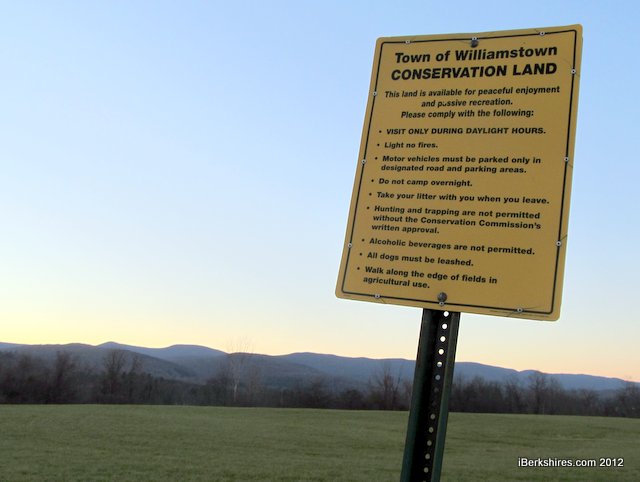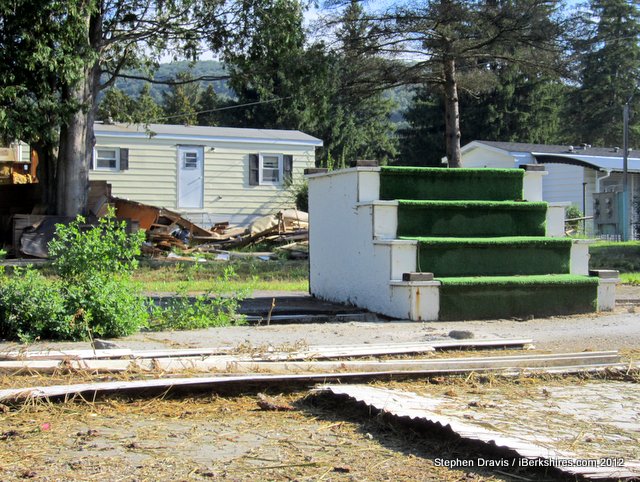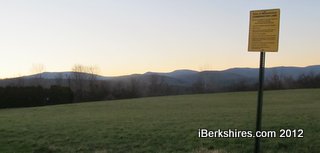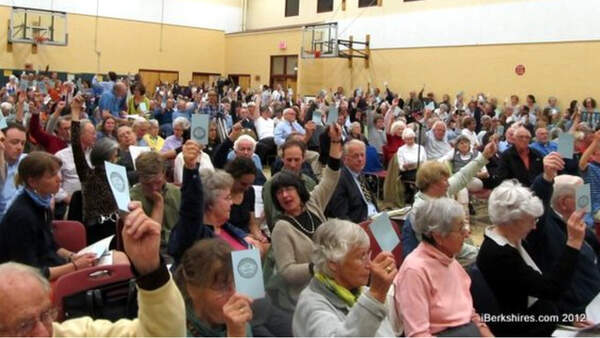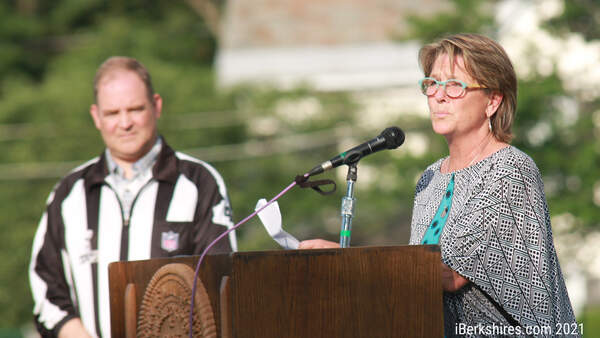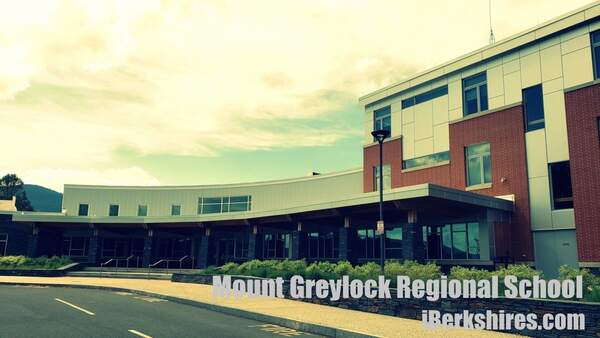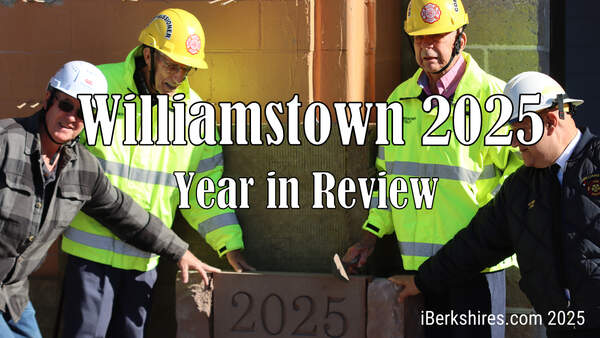Williamstown Faces Question of Priorities

The former town garage site has become an unofficial community parking lot, as seen in this photo taken Saturday, Oct. 13, during the Williams College football team's home game against Middlebury. The site is one of four being considered for affordable housing development. |
WILLIAMSTOWN, Mass. — Ask 10 people on Spring Street whether affordable housing should be a priority for the town, and at least nine probably will agree it should.
Ask the same folks whether local agriculture is a good thing, and the same number probably will say it is.
Therein lies the problem.
A plan to address one of the town's pressing needs is threatening to cut into the efforts of those dedicated to pursuing another laudable goal. More and more, it is looking like the town will have to choose which goal is more important.
On Nov. 13, Town Manager Peter Fohlin announced that the town was applying for a grant that would allow it to purchase the storm-damaged Spruces Mobile Home Park and dedicate $3 million toward constructing new affordable housing on town-owned land that is currently in conservation.
The town is eyeing a 30-acre parcel off Stratton Road known as the Lowry property. Currently, that land is leased to a local farmer who uses it for hay to feed his livestock.
The fact that the town is considering steps to take the land out of conservation has sparked a meeting of concerned citizens scheduled for Wednesday evening and drawn the attention of at least two town committees: the Conservation Commission, which manages all town land in conservation, and the Agriculture Commission.
Ag Commission Chairwoman Beth Phelps said this week that her panel was not aware of the proposal to move toward developing the Lowry property until it was announced at the Selectmen's meeting.
"My first reaction was favorable toward the town acquiring the Spruces property," she said. "I still am favorable about that. It would be great to have those folks out of that dangerous area, and it would be great for the town to have public land for a park or a farmers market, a dog park — all the things we can't do on Field Park because it's on the rotary.
"However, I'm very disturbed that they went ahead and chose the Lowry property without discussing it with any of the other committees. It seems to me that there are other options on the table."
Other options
Indeed, there are four town-owned properties under consideration by the town's Affordable Housing Committee as sites that could be developed. Two would be "brownfields" developments: the former town garage site on Water Street and the former PhoTech Mill property on Cole Avenue. A fourth, the 139-acre Burbank property, is, like Lowry, in conservation and currently leased to a local farm.
Of the four, only Photech currently stands completely idle. While the two green spaces are actively farmed, the town garage site is a well-used parking lot conveniently located to commercial properties on Spring Street and Water Street and Williams College. (The Planning Board also has considered the site a prime location for residential/retail development.)
Another conceiveable option — buying land not currently owned by the town — is less attractive than using property already under town control, according to the chairman of the Affordable Housing Committee.
"There's no acquisition costs," Catherine Yamamoto said. "That contributes to the ability to make it affordable for the developer and ultimately for the rents that will be charged.
"Occasionally, we come across or are contacted about privately-owned parcels in town. We do look at those, but it takes money to buy them. ... If we have to put out several hundred thousand dollars up front to buy the land," she said, there will be little left to build subsidized housing on it.
Yamamoto's committee identified the town garage site, also known as 59 Water St., as its top priority before Fohlin announced his proposal to develop the Lowry property and likely will continue to work on the downtown site first - partly because the process of taking land out of conservation could take years, a point Fohlin conceded during his pitch to the Selectmen.
The town is seeking clarification from town counsel about what that process entails, but it is believed it involves — among other things — an act of the Legislature. Part of Fohlin's proposal involves placing the 114-acre Spruces property in conversation to offset the 30 acres that would be taken out of conservation on Stratton Road.
By contrast, the process of developing the former town garage site would involve a simple vote of the Selectmen. In 2005, town meeting transferred control of the property to the Board of Selectmen and authorized it to sell the land to a developer.
The Water Street site has other advantages, too, Yamamoto said.
"It's close to services and transportation," she said. "We're thinking it's not an ideal place for families, but it would be a good place for one- or two-person households of all ages."
What neither the town garage site nor Photech has going for it is acreage.
The 59 Water St. property is 1.3 acres, and the Yamamoto estimates it could develop as many as 30 units in one or two buildings.
|
The proposal to build housing on long-conserved land has prompted the call for a public meeting on the issue. |
"Given the existing structures and configuration of the land to the north (toward Main Street), it could accommodate a three- to four-story building built in the character of the existing structures around here," she said.
"We're hoping we could maximize it by maybe building two buildings — one that would front on Water Street and then one that would be build along, possibly, a new street running between Water Street and Meacham Street between the existing houses on Meadow Street and the building here on the property with green space and parking between the buildings here.
"It could be very, very attractive, and, I think, a real asset to the town."
But it would not solve the entirety of Williamstown's affordable housing problem, Yamamoto said.
What is affordable?
How much affordable housing does the town need? That is difficult to say because the term "affordable housing" itself is difficult to define.
Generally speaking, the federal Department of Housing and Urban Development defines it as housing that costs 30 percent or less of a household's income. How that is applied to a specific geographic region or socio-economic group is a little murkier.
Even the Massachusetts Affordable Housing Alliance has trouble defining the concept without using fairly vague language.
"The homes listed on this website were built for households earning a low or moderate income," the MAHA says on massaffordablehomes.org. "Some are affordable for people earning up to 80 percent of the area median income, others have income limits at 100 percent of the area median."
According to the non-profit group, Williamstown falls well short of the goal the Legislature has set of each town in Massachusetts offering 10 percent of its housing stock as "affordable," but then again so do the vast majority of the commonwealth's cities and towns.
MAHA lists Williamstown as having 4.8 percent of its 2,926 housing units as subsidized housing. Only two communities in Berkshire County (North Adams at 12.6 and Stockbridge at 11.3) surpass the 10 percent threshold.
The town's Master Plan, approved in 2002, said Williamstown was 164 affordable housing units short of meeing the 10 percent goal, and the only major affordable housing development since '02, the former St. Raphael's Church and rectory on Cole Avenue, added just eight affordable units to the town's inventory.
Whatever the town's deficit in 2002, the problem was exacerbated by Hurricane Irene, which wiped out 153 homes at the Spruces and left the remaining 67 homes in limbo. Another bad flood could potentially wipe out more residences, but even if it does not, the park's owner, Morgan Management, is on record saying it cannot continue to operate the park at its current occupancy rate.
"What just happened with Hurricane Sandy highlights the fact that we still have people living in harm's way," Yamamoto said. "We have 100 people living in the Spruces, 64 households, and they cannot go on much longer living there. They're safe until the next flood. That could be next week or next spring we just have to be proactive and provide the opportunity for those people to move to a safe place to live."
|
The town's affordable housing count shrunk in the wake of Hurricane Irene, which damaged more than 150 homes in the Spruces retirement community. |
Current use
While Yamamoto envisions a housing development at 59 Water St. that would be "an asset" to the town, the site already is an asset to the local economy. Drive past the old town garage site on any given week day, and you likely will see a couple of dozen cars parked on the unpaved lot.
Drive past on a fall Saturday when the Williams College football team is home or on a Saturday in the winter when the basketball teams are in action, and you might see a hundred cars crammed into that 1.3 acres.
Although those cars — and the people they bring to the commercial district — are vital to Williamstown's economy, parking does not engender the same kind of fervor that this month spawned the nascent Friends of Williamstown Conservation Lands.
Although the college stands to face a major headache when all those cars on football Saturdays need to park elsewhere, a Williams spokesman said he was not worried about the plans to develop 59 Water St.
"We're certainly following all discussions in town," Williams Assistant to the President for Public Affairs James Kolesar said. "I think what I would say is any plan to use that space would have to include consideration of the effect on parking.
"I assume good decisions will be made."
Yamamoto said she has not heard any voices raised in opposition to developing the former town garage site, and she notes that the 2005 Town Meeting article authorizing its sale passed "overwhelmingly."
"[Parking] is an issue that has to be addressed, and we have to keep in mind that if the fire station (across Water Street) moves, that site would become available, and perhaps parking could go there," she said. "It's a very small, long, narrow site right by the river, so I'm not sure.
"But parking is an issue, definitely."
|
Nor are Yamamoto and her group unsympathetic to those who want to see agricultural land preserved at the Lowry property, though it is worth noting that the 2002 Master Plan specfically mentions that site as one with the potential for development to meet the town's affordable housing needs.
The Affordable Housing Committee, which has one member (Van Ellet) who also serves on the Conservation Commission, deliberated long and hard this summer and fall before approaching the Con Comm about possibly developing either Lowry or Burbank. It did so at the conservation panel's Nov. 8 meeting and received a lukewarm reception.
Coincidentally, that meeting was attended by the person mostly likely to be directly affected by the Spruces-Lowry land swap proposed five days later. Kim Wells, owner of East Mountain Farm, was before the Con Comm to renew his three-year lease on the Lowry property.
Wells, who serves with Phelps on the Ag Commission, said the loss of the land to development would hurt his farm and, in the long run, the town. But he also hinted at the dilemma the town faces.
"It's fantastic soil," he said. "To have this property has allowed me to grow my farm. I would not have that beef operation if I didn't have the hay [grown on the Lowry property].
"I don't want to make it a battle between East Mountain Farm and affordable housing.
"I've been haying it since the late '80s or early '90s, and there's precious little farmland like this in Williamstown. To me, it's not about me getting hay off of it. It's about preserving it as usable farmland for the future."
Tags: affordable housing, agricultural commission, conservation restriction, land conservation, Planning Board, Spruces,

